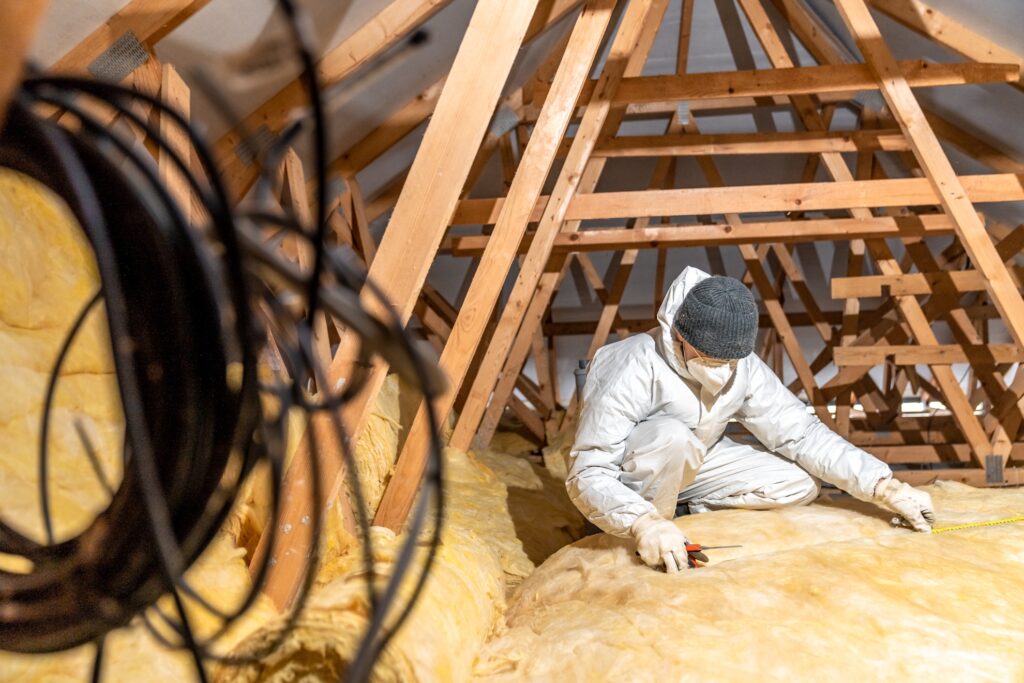
Upgrading your home’s attic insulation has many benefits, from better energy efficiency to reduced heating and cooling expenses. To take full advantage of these benefits, however, you have to install the right type of insulation.
In this guide, we cover the best attic insulation materials and break down the pros and cons of each to help you learn more about your attic insulation options.
Types of Attic Insulation
There are several types of attic insulation, all of which have their advantages and drawbacks. These are the most common types of insulation for an attic:
Fiberglass Batt Attic Insulation
When you picture insulation, fiberglass batts are probably what comes to mind. They’re made from molten glass that’s spun into fibers and then attached to a paper backing to create batts or rolls. The paper is specially treated and acts as both a vapor barrier and a fire retardant.
Pros & Cons of Fiberglass Batt Insulation
Fiberglass batt attic insulation has many benefits:
- Affordable – Fiberglass batts are one of the most affordable insulation materials.
- Non-flammable – Fiberglass batt insulation is fire-retardant and can improve your home’s safety.
- Effective – Fiberglass batts perform well and will increase your home’s energy efficiency when installed correctly.
- Eco-friendly -Fiberglass insulation is typically made from recycled materials.
Fiberglass batts also have some cons:
- Safety – Fiberglass insulation must be handled with protective gear to prevent injury.
- Durability – Fiberglass batts don’t last forever and will eventually need to be replaced.
- Air leakage – Fiberglass batts are not an air sealant. They must be installed alongside an air sealing material for maximum effectiveness.
Blown-In Attic Insulation
Blown-in insulation (also called loose-fill insulation) is installed by blowing loose insulation material into a space using a hose. It’s typically made from cellulose or fiberglass and used to fill large open spaces, like an attic floor.
Pros & Cons of Blown-in Insulation
The benefits of blown-in fiberglass or cellulose insulation include:
- Performance – Provides excellent coverage and fills gaps and spaces that other types of insulation might miss, improving energy efficiency.
- Fits hard-to-reach spaces – Ideal for attic floors because it conforms to the space it’s installed in without disturbing structures or finishes.
- Adjustable depths and densities – Installers can control the depth and density of the insulation to achieve the desired R-value.
- Air sealing qualities – While not an air barrier, it can somewhat reduce airflow.
Some downsides to consider when installing blown-in attic insulation include:
- Installation complexity – Installing blown-in insulation requires specialized equipment and skill to ensure proper density and coverage, which is not suitable for a DIY approach.
- Moisture sensitivity – If moisture gets into the insulation, it will lose its effectiveness and could result in mold growth.
- Consistency – If not uniformly applied, it can result in varying R-values in different areas.
Foam Attic Insulation
Foam insulation is becoming an increasingly popular choice for attics. There are two types of foam insulation: rigid foam board and spray foam.
Rigid foam board insulation is a type of insulation that comes in large, firm sheets that can be cut to size for installation.
Spray foam insulation is a chemical product created by mixing and reacting unique liquid components that, when combined, expand quickly to fill the space they’re applied to with a dense, foam-like substance. It provides both insulation and air sealing and comes in two main types.
Pros & Cons of Foam Attic Insulation
Foam insulation has many advantages:
- Performance – Foam insulation has a high R-value and will increase your home’s energy efficiency.
- Air sealing – Many foam insulation materials act as an insulator and air sealant in one.
- Moisture barrier – Foam insulation is waterproof and creates a moisture barrier.
- Longevity – Foam insulation, especially spray foam insulation, lasts a very long time.
- Pest deterrence – Foam insulation does not attract rodents and insects because, unlike some other insulation materials, it is not a nesting material or a source of food.
Foam insulation also has some cons:
- Installation – Spray foam insulation is dangerous if mishandled and must be installed by a professional.
- Permanent – Once spray foam hardens, it can be difficult to remove or modify. It adheres strongly to the surrounding materials, which can make future renovations or repairs more challenging.
Find the Best Type of Insulation for Your Home
Every home is different and the best type of attic insulation for your home will depend on a variety of factors. Neeeco can recommend the best insulation material for your attic during a no-cost Home Energy Assessment. We are a highly accomplished insulation company in Massachusetts with many years of experience installing attic insulation and air sealing. Our expert team can evaluate your attic and recommend the best upgrades to improve energy efficiency in your home.
